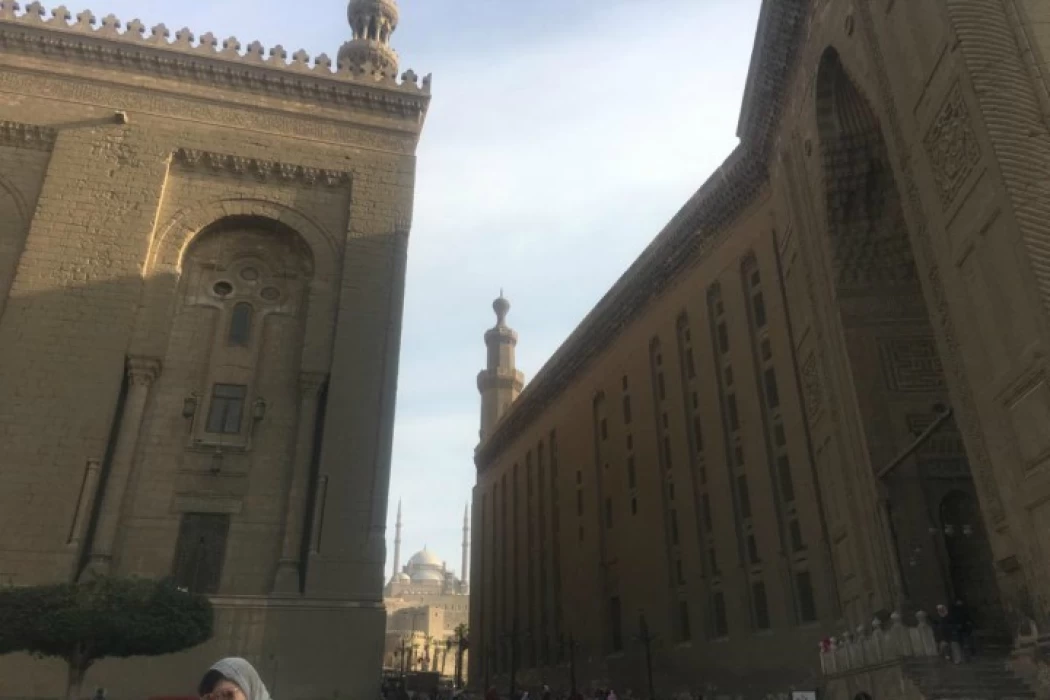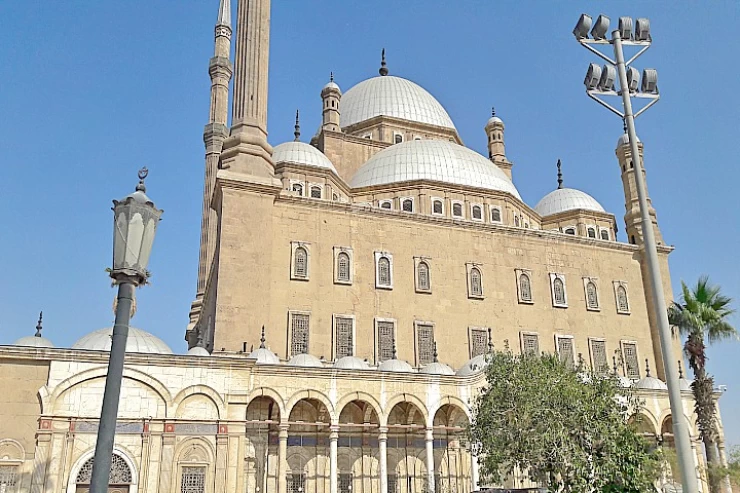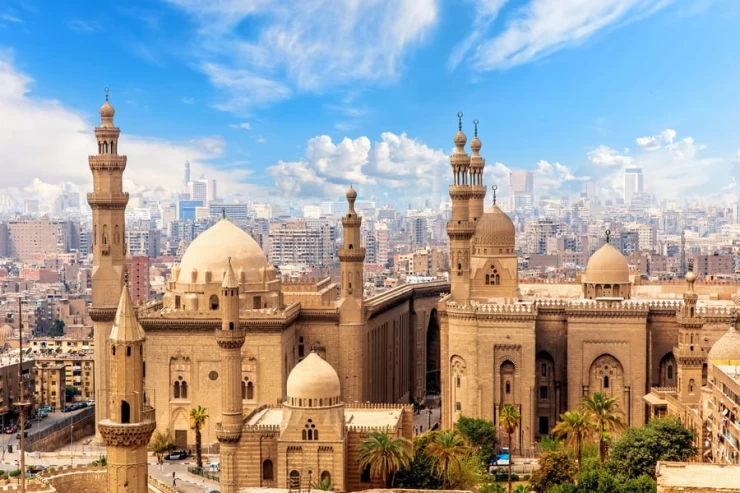
苏丹-哈桑建筑群
庄严的苏丹-哈桑清真寺和伊斯兰学校建筑群
苏丹-哈桑清真寺和宗教学校是开罗最令人惊叹的伊斯兰建筑之一,这座清真寺坐落在开罗老城内部的萨拉丁城堡周围也就不足为奇了。该建筑群体现了马穆鲁克建筑史诗般的比例,以其巨大的规模、精美复杂的图案和细节以及它的过去而闻名于世。世界各地的游客都会朝圣这座建筑和文化杰作的美景和历史,它是马穆鲁克苏丹国的骄傲。
历史概况
公元 1356 年左右,苏丹哈桑-本-纳西尔-穆罕默德(Hassan bin al-Nasir Muhammad)委托建造了这座清真寺和坎儿井大院,他希望这座清真寺不仅仅是一座清真寺,还能作为伊斯兰教逊尼派四大教派的学习学校(madrasa): 哈乃斐教派、马利基教派、沙菲教派和汉巴利教派都在这里学习。陵墓于 1356 年基督教时代开始修建,历时约七年才完工。它还被用作学习和礼拜的场所。但遗憾的是,在苏丹下令进行最后和最宏伟的设计之后,苏丹在几个小时内就被暗杀了,从而加深了这个神话。
这座建筑群建在一座城市中,多年来,这座城市的历史曾多次中断,内部地震和军事围困都对其建筑设计造成了不利影响。但它仍然是马穆鲁克统治和虔诚的重要象征,并继续开放供人朝拜和参观。
宏伟的建筑
虽然苏丹-哈桑建筑群有很多看点,但其巨大的规模无疑是最令人印象深刻的特色。高不到 26 米的主入口通向一个庭院,庭院四周是高达 36 米的围墙。整个清真寺占地约 7900 平方米,是全球最大的清真寺之一。建筑采用对称的石材立面,大量使用几何装饰和装饰性纪念碑,是典型的马穆鲁克建筑设计。
此外,在清真寺内部,除了一个伊瓦布之外,还设有四个逊尼派伊斯兰教流派和一个大的中央庭院,庭院由四个伊万环绕。位于中央、指向麦加的伊旺用精致的灰泥和大理石装饰,还有一个装饰一新的 “米哈拉布”。庭院也通过柱子形式的垂直构件进行了适当的布置。客人们还会欣赏到空间中的高墙,高墙的天花板呈弧形,给人一种近乎空灵的感觉
伊斯兰学校 学习中心
伊斯兰学校(Madrasa)是伊斯兰教的主要机构,也是建筑群最初的设想目标之一。因此,所有四个伊斯兰教堂也都是逊尼派司法学校之一的教室。这一时期也解释了为什么这些杰出的人物会出现在内室中,周围围绕着来自穆斯林世界各个角落的学生,因为它被推崇为教育的顶峰。
学校还致力于学生的健康。这意味着除了提供常规课程外,还为学生提供营养、宿舍和阅览室。伊斯兰学校的墙壁上挂满了《古兰经》经文,这些经文既是装饰品,也是激励学生学者的资源。
苏丹-哈桑陵墓
同样引人入胜的还有苏丹-哈桑陵墓,它是苏丹-哈桑建筑群的另一个特色元素。该墓位于主祈祷室的后面,据说是保存最完好的穆穆鲁克墓葬建筑之一。穹顶上有一个高达 21 米的巨型圆顶,上面点缀着精美的阿拉伯式花饰和铭文。陵墓内有苏丹哈桑的石棺,石棺被镶嵌着马穆鲁克风格杰作的大理石墙壁所包裹。
有趣的是,苏丹-哈桑的遗体从未安葬在这座陵墓中,因为他在建筑群完工之前就已遇害,遗体被埋葬在其他地方。不过,这座陵墓仍然是一个具有象征意义的安息之地,也是对他的美好纪念。
伊斯兰艺术之旅
苏丹-哈桑建筑群是伊斯兰艺术和建筑的杰作,每一个细节都经过精心设计,符合马穆鲁克风格。墙壁和天花板上饰有阿拉伯式花饰、几何图案、书法和其他典型的伊斯兰艺术元素。表面上点缀的鱼尾纹和灰泥雕刻作品,清楚地表明了整个建筑群在建造过程中的非凡艺术性。
在主要的艺术品中,不能不提的是精美的木制马什拉比亚,上面有精致的花卉和几何雕刻,让人忍不住想一探究竟。除了提升建筑群的美感之外,这些屏风还能起到通风和保护隐私的作用。米哈拉布是清真寺的另一亮点,它由大理石制成,并饰有装饰板和马赛克,给人一种精神上的享受。
游览今天的建筑群。
目前,苏丹-哈桑清真寺建筑群仍然是开罗游客的必游之地。虽然清真寺仍用于宗教仪式,但它向公众开放,让所有人都能领略其建筑设计的壮丽之美。在清真寺内徜徉,品尝玛玛拉苏酒(mama rasu)的同时,还可以放松身心,欣赏周围的美景和寺内的历史艺术。
苏丹哈桑建筑群: 必游景点
苏丹-哈桑清真寺和伊斯兰学校建筑群将开罗的伊斯兰历史以一种有趣的方式呈现给最狂热的阶层。由于其丰富的建筑和历史背景,它是埃及最精美的寺庙之一。这些景点还包括参观苏丹-哈桑建筑群的建筑奇迹,让人们看到并感受到马穆鲁克古迹的宏伟气势,这也是它成为每次开罗之旅必不可少的旅游景点的原因。
The Mosque and Madrasa of Sultan Hassan is one of the most stunning examples of Islamic architecture in Cairo, and it is not surprising that the mosque is situated around the Citadel of Saladin, in the interior of Old Cairo. The complex embodies the epic proportions of Mamluk architecture and is famous for its great scale, beautiful intricate patterns and detail, and its past. Visitors around the globe make pilgrimages to the beauty and history of this architectural and cultural masterpiece, which is the pride of the Mamluk Sultanate.
Historical Overview
This mosque and khanqah compound construction was commissioned by Sultan Hassan bin al-Nasir Muhammad around the year 1356 AD, and he intended it to be more than a mosque as it would serve as a madrasa (school of study) for the four major Sunni sects of Islam: Hanafi, Maliki, Shafi’i, and Hanbali. The construction of the tomb was commenced in the 1356 Christian era, which took around seven years to complete. It was also used as a place to learn and worship. But the bad part was that, alas, within a matter of hours, after the Sultan ordered his last and grandest design, the Sultan was assassinated, thus enhancing the myth.
The complex was built in one of the cities that over the years have suffered many interruptions within its history, internally due to earthquakes as well as military sieges, some of which rendered its architectural design adversely. But it has remained a significant symbol of Mamluk rule and devotion and continues to be open for worship and visitors.
While the Sultan Hassan Complex has much to offer, its enormous scale is undoubtedly the most impressive feature. The main entry that is just under 26 meters in height leads to a courtyard that is surrounded by walls that rise to a height of 36 meters. The entire mosque covered about 7900 square meters, making it one of the biggest mosques in the globe. The building’s symmetrical stone elevation and rich use of geometrical decor and ornamental monuments are typical Mamluk architectural designs.
Also, within the mosque’s interior—except for the one iwab—which houses four schools of Sunni Islam and a large central courtyard, which is encircled by four iwans. The Iwan located at the center pointing to Mecca is enhanced with elaborate stucco work and marbles, as well as a decorated'mihrab.'.’ The courtyard is also properly arranged with the help of vertical members in the form of columns. The guests will also admire the lofty walls of the space, which have curved ceilings, creating an almost ethereal feeling in the room.
The organization, which is popularly referred to as the madrasa or Islamic institution in its primary sense, was one of the objects of the original vision of the complex. So all four iwans also served as classrooms for one of the Sunni judicial schools. This period also explains the presence of such illustrious personages in the inner chambers surrounded by students hailing from every corner of the Muslim world due to its esteem as the pinnacle of education.
The institution committed to the good health of its students as well. This implied that in addition to regular classes being offered, nutrition, dormitories, and a reading room were also provided to the students. The madrasah is covered by Koranic verses placed on the walls as ornaments and motivational resources for the student scholars who were within its confines.
Equally intriguing is the tomb of Sultan Hassan, which is another distinguishing element of the Sultan Hassan Complex. The tomb is in the back of the main prayer room and is said to be one of the best preserved examples of Mumluk burial architecture. The dome is surmounted by a giant dome that is 21 meters in height and is embellished with beautiful arabesques and inscriptions. Based within the mausoleum, there lies the sarcophagus of Sultan Hassan, encased in walls of marble embedded with Mamluk-style masterpieces.
Interestingly, Sultan Hassan’s body was never interred in this mausoleum, as he was killed before the complex was completed, and his remains were buried elsewhere. Nevertheless, the mausoleum remains a symbolic resting place and is a beautiful tribute to his memory.
The Sultan Hassan Complex is a superlative work of Islamic art and architecture, with every detail thoughtfully designed and executed to fit the Mamluk style. The walls and ceilings are clad in arabesques, geometric designs, calligraphy, and other typical components of Islamic art. The fishtail and stucco carving works, embellished on the surfaces, unequivocally demonstrate the exceptional artistry that went into building the entire complex.
Among the dominant artistic aspects, one cannot miss the beautiful wooden mashrabiya, which has elaborate floral and geometric carvings in it, encouraging the eye to explore its design. In addition to enhancing the beauty of the complex, these screens also provide ventilation as well as privacy. Another thing that adds beauty to the mosque is its mihrab, which is made of marble and embellished with decorative panels and mosaics that instill a certain level of spirituality.


















